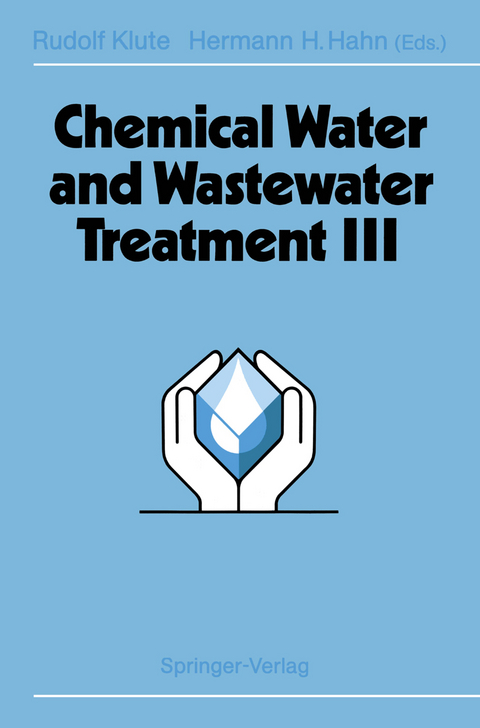
Chemical Water and Wastewater Treatment III
Springer Berlin (Verlag)
978-3-642-79112-3 (ISBN)
Exactly ten years ago an experiment was started that proved to be extremely successful: the First Gothenburg Symposium. Its intent was to further the under standing of all processes pertaining to Chemical Water and Wastewater Treatment, and to bring together specialists working in basic research as well as in devel opment and administration. Now, the Proceedings of the Sixth Symposium are about to be published, clearly proving that there is a need for this forum. They dramatically illustrate the significance and the dynamic development of the topics of these symposia. It is fascinating to witness that in this time of reduced economic growth or even standstill, the environmental drive has not come to a halt, as many anticipated or feared. It is accepted more and more that the protection of the environment, a constant theme in all the Gothenburg Symposia, is not only a topic to be dealt with in times of affluence; it is now also seen as an instrument for cutting ex penditure, saving energy, and husbanding resources. The ever growing interest in these Gothenburg Symposia, documented by the large number of contributions the scientific panel received and the large demand for the books of this series that always exceeds the supply, testify to this commitment.
The Gothenburg Symposia and their proceedings cover urgent international environmental issues: quality assurance for drinking water and pollution control in wastewater. In times of limited clean water resources in most densely populated areas and growing concern for environmental pollution, the Gothenburg Symposia discuss practical solutions for water and wastewater treatment.
Floc Formation and Separation.- Dissolved Air Flotation: Pretreatment and Comparisons to Sedimentation.- The Use of Factorial Designs to Identify Factors Affecting Particulate Removal in a Full Scale Tertiary Precipitation Plant with Flotation.- Membrane Microfiltration of Secondary Wastewater Effluent.- Chemicals and Dosing Control.- Influence of the Basicity of Polyaluminium Chlorides When Cleaning Municipal Wastewater.- Inorganic Polymer Flocculant Polyferric Chloride, Its Properties, Efficiency and Production.- Preliminary Evaluation of Polyferric Sulphate As a Coagulant for Surface Water Treatment.- Stabilized Ferrates (VI): Synthesis Method and Applications.- Coagulant Dosing Control Using a Model for Wastewater Coagulation.- Coagulation of Humic Water with Fenton Reagent.- Drinking Water Treatment.- Aspects on Future Drinking Water Treatment in Sweden.- Coagulation and Corrosion Control for Soft and Coloured Drinking Water.- Optimal Use of Ozonation and GAC in Direct Filtration for Drinking Water Treatment.- Combined Design, Operation and Economic Optimization of Contact Filtration.- Wastewater Treatment.- Chemical Wastewater Treatment - Value for Money.- The Use of Polymer in the Pre-precipitation Step of a Wastewater Treatment System for Extended Nutrient Removal.- The Use of Reagents in Up-flow Submerged Biofilters.- The SIROFLOC Sewage Treatment Process: A High Rate Process for Sewage Clarification.- Full-Scale Experiences from Biological Nitrogen Removal Combined with Different Phosphorus Removal Alternatives at Öresundsverket in Helsingborg.- Upgrading Point Loma Treatment Plant in San Diego with Improved Advanced Primary Treatment.- Industrial Waste Management: The Case of the Tannery Industry.- Stormwater Treatment.- Characterization and Advanced Treatment of Urban Stormwater from a Separate System.- Dissolved Air Flotation: Efficient Removal of Micropollutants from Stormwater Runoff.- High Speed Settling of Stormwater with Microsand.- Sludge Handling.- Chemical Treatment - Consequences for Sludge Biosolids Handling.- Full Scale Experiences with Thermophilic Aerobic Digestion of Primary-Chemical Sewage Sludge.- Beneficial Use of Sludge from Sewage Plants and Water Works.- Phosphate Fixation in Sludges from Enhanced Biological P-Removal During Stabilization.- Use of Streaming Current and Other Parameters for Polymer Dose Control in Sludge Conditioning.
| Erscheint lt. Verlag | 13.12.2011 |
|---|---|
| Zusatzinfo | XI, 381 p. |
| Verlagsort | Berlin |
| Sprache | englisch |
| Maße | 155 x 235 mm |
| Gewicht | 603 g |
| Themenwelt | Naturwissenschaften ► Biologie ► Ökologie / Naturschutz |
| Naturwissenschaften ► Chemie ► Technische Chemie | |
| Naturwissenschaften ► Geowissenschaften | |
| Technik ► Elektrotechnik / Energietechnik | |
| Technik ► Umwelttechnik / Biotechnologie | |
| Schlagworte | Abwasserreinigung • Drinking Water • pollution • pollution control • Wasseraufbereitung • Wasserreinigung • wastewater • Wastewater Treatment • Water • Water Quality and Water Pollution • Water Quality Assurance • water supply • Water Treatment |
| ISBN-10 | 3-642-79112-3 / 3642791123 |
| ISBN-13 | 978-3-642-79112-3 / 9783642791123 |
| Zustand | Neuware |
| Haben Sie eine Frage zum Produkt? |
aus dem Bereich


